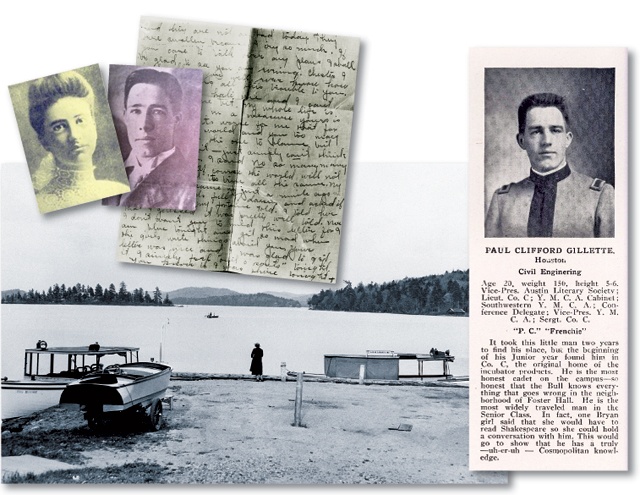Perhaps only an English major, or an Aggie English professor for the past 40 years, was likely to discover Paul Clifford Gillette, Texas A&M class of 1913. A century ago, this Houston “native” graduated from A&M as a member of Corps Company C. Known to his fellow cadets as “P.C.,” he wasn’t actually from Houston, but from all over the country. Born in 1893 in Spokane, Washington, he died on the island of Maui in Hawaii in 1973.
Throughout his four years as a student in College Station, Paul carried with him a huge secret. His parents, Frank and Louisa, identified themselves in the 1900 census as preachers for the Salvation Army. They traveled the nation’s major cities with their street ministry, one that involved the participation of their four children, two daughters and two sons. Paul was their youngest child. His brother, Chester, born in 1883, had been executed for murder in 1908 at the Auburn State Prison in New York.
This was Paul Gillette’s secret.
Described as the “crime of the century,” as other well-publicized murders were in the last century (the Loeb-Leopold trial of the 1920s involving Clarence Darrow, known as the “attorney for the damned,” and the O.J. Simpson trial of the 1990s), it became the basis of one of the greatest American novels of the 20th century: Theodore Dreiser’s “An American Tragedy,” published in 1925.
Chester was convicted of drowning his girlfriend Grace Brown. She had been an employee in a factory owned by Chester’s wealthy uncle, who otherwise had been long estranged from his impoverished street preacher brother, Frank. Chester had left his parents’ ministry and traveled far and wide, failing as a student at Oberlin College preparatory school, working as a brakeman for the railroad and, finally, in 1905, ending up as an employee of his uncle’s collar factory in Cortland, New York.
Chester was fascinated by the American dream of becoming rich. But a woman he had befriended, a co-worker named Grace Brown, became pregnant with his child and thus an obstacle between Chester and the opulent life of his uncle’s upper-class family.
The subsequent murder trial was sensationalized by the newspapers of the day because the crime involved a supposedly rich boy and an impoverished girl. The New York World, which gave the trial its most intense coverage, also published Grace Brown’s letters to Chester in which she begged him to marry her and save her from what was then absolute scandal.
In “An American Tragedy,” as in the real-life case it mirrored, Chester’s character, Clyde Griffiths (bearing the same initials as Chester Gillette), takes his girlfriend Roberta Alden (Grace Brown) to a lake resort in the Adirondacks on the premise that they will marry there, far enough from Cortland to avoid scandal. In Dreiser’s novel, the young man takes his girlfriend out on a lake in a boat. When she accidentally falls in the water, he fails to save her, knowing all the while that she cannot swim.
At his trial, Chester maintained his innocence, claiming that Grace had committed suicide by throwing herself overboard when he threatened to inform her parents of the pregnancy.
After the execution, the Gillette family, including 15-year-old Paul, moved to Houston, a city far away from the scandal and Chester’s execution. Chester’s last words, quoted in New York newspapers, included advice to Paul to remain on the straight and narrow.
In the 1910 census, Frank Gillette gave his occupation as “stationary engineer,” somebody who maintains power plants. His son, Paul, went to A&M, graduated with a degree in civil engineering and went on to graduate studies in the same subject at the University of Wisconsin in 1917.
Paul held the cadet rank of lieutenant when he graduated from A&M. He is described in “The Longhorn,” the A&M yearbook, as “the most honest cadet on the campus—so honest that the Bull knows everything that goes wrong in the neighborhood of Foster Hall. He is the most widely traveled man in the Senior Class. In fact, one brave girl said that she would have to read Shakespeare so she could hold a conversation with him.”
This description suggests that by 1913 Paul had managed to put his past somewhat behind him to become a graduate of Texas A&M. It apparently hadn’t been easy at first. “It took this little man two years to find his place,” his yearbook description noted, “but the beginning of his Junior year found him in Co. C, the original home of the incubator products.”
Twelve years later, however, his family’s past came back to haunt him, in the form of Dreiser’s book—the first major “nonfiction” novel in American literature, a literary feat repeated by Truman Capote’s “In Cold Blood” (1967) and Norman Mailer’s “The Executioner’s Song” (1979). It had been one thing to be the younger brother of a convicted killer. It was another to have that brother’s crime enshrined in a famous novel.
——————–
Jerome Loving is distinguished professor of English at Texas A&M University and the author of a number of biographies about literary figures, including ‘The Last Titan: A Life of Theodore Dreiser’ (University of California Press, 2005). He is a member of Bryan Texas Utilities.


